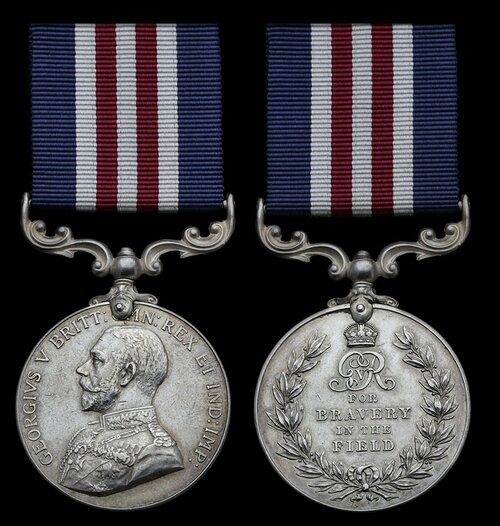
Auction: 21003 - Orders, Decorations and Medals
Lot: 543
A rare posthumous M.M. awarded to Air Mechanic 1st Class O. F. Watts, Royal Flying Corps, who flew as an Observer with No. 18 Squadron in France and was decorated for his part in a daring bombing raid on Fremicourt Aerodrome on 10-11 Novmber 1916; he would not live to receive his M.M., for Watts was killed in action on 27 November 1916 in aerial combat, becoming the second victory of German Ace - and recipient of the Pour le Merite - Werner Voss of Jasta 2, Wingman of 'The Red Baron'
Military Medal, G.V.R. (20732 1.Cl:A.M. O. F. Watts 18/Sq: R.F.C.), good very fine
Exhibited:
100 Years of the Royal Air Force, April 2018, Spink.
M.M. London Gazette 22 January 1917. The original citation from No. 18 Squadron states:
'For conspicuous gallantry on the night of November 10-11th as passenger whilst night flying over the enemy lines having already expended all his bombs he attacked a train by machine gun fire from a height of 100 feet and set it on fire.'
Oliver Frederick Watts was born in September 1894 at Aston, Birmingham and was a motor mechanic by trade upon his joining the Royal Flying Corps at Birmingham on 4 November 1914, going down to Farnborough two days later. Serving in France from 8 November 1915, he joined No. 18 Squadron on 1 October 1916 as an Observer. Young Watts would have a fateful two months with the Squadron. Their War Diary records on 10 November 1916:
'During a night bombing run Lieutenant P. C. Campbell (Pilot) and 1.A.M., O. Watts (Observer) observed what they thought to be lights of an aerodrome at Fremicourt. The lights were red making a triangle. The aerodrome appeared to be situated in the S.W. corner of Buissy. They dropped their bombs and the lights were immediately put out and a party opened fire on them. On their way home they observed four trains in Queant Station and came down to 300 feet and opened fire on them.'
Royal Flying Corps Communiqués 1915-16 gives further details
'Crossed the line by following the railway from Albert to Arras to Achiet-le-Grand and then West. Identified Ervillers by bend in road; also Behagnies and Sapignies. A train was going North along the St. Ledger - Boyelles railway. We came down to 2,000 feet but did not bomb it as I thought it might be empty. I then followed railway until I saw three balloon sheds. Dropped one 20lb Hales and two incendiary bombs. They missed the sheds, but hit a shed in the town. The bombs were dropped from 2,000 feet. I then saw a train coming West, just West of Ecoust. I caught up the train from behind, it was a short one composed of four closed and three open trucks. The latter were full of boxes, we were 100 feet above it and I dropped the one single bomb remaining on right side, but it fell behind the train. The other four fell on the second closed truck behind the locomotive. The explosion knocked back my Observer, who was leaning forward and made my machine sway. We then circled round and emptied two drums into the train, which had stopped. The light on the tail of the train was still lit, also the headlights, then we went West again and climbed to about 3,000 feet. We saw another train coming from Boyelles to St. Leger. We came down to the North side of the train and turned to follow it. My Observer opened fire at it at about 200 yards range when we were about 200 feet up. He got about two shots into the centre of the train. The next few shots were just low, the next ten or so went over, the remainder hit the train, including the front of it about the engine, which put on speed. I crossed the line and gave my Observer time to change the drum and then turned to the left and flew over the train again, going down to 100 feet. My Observer got the range and emptied all the second drum into the front carriages and engine, which stopped and gave off clouds of steam. We then turned West and came down and the next one went over me about 500 feet or so. I then turned North for a minute or so and then West. No more rockets were fired.'
Watts was duly put forward for and would be approved for the award of the M.M., but fate would step in. His flight on 27 November 1916 would be his last:
'Whilst flying in Artillery co-operation and taking photographs during a line patrol at 1300 Lieutenant F. A. George (Pilot) and 1.A.M., Watts (Observer) were brought down by two hostile machines near Ginchy. The first shots fired broke the pilot's leg and went through the petrol tank. The machine fell in flames and the Observer 1.A.M., Watts was killed.'
Flying Fe2B 4915, having been shot down near Bapaume, they were claimed by Oberleutnant Werner Voss, becoming his second victory. Voss notched up no less than 48 Victories before himself being killed in action on 23 September 1917. Voss had only joined the vaulted Jasta 2 on 21 November and had scored his first victory that morning, his pair of Victories earning him the Iron Cross First Class, awarded on 16 December 1916. Voss was a close friend and flew as Wingman of Manfred von Richthofen - The Red Baron - whilst with the unit.
Watts, aged just 23, is buried in the Corbie Communal Cemetery Extension, France; sold together with copied research and extracts which confirm further entitlement to 1914-15 Star Trio.
For the M.C. group to his Pilot, Campbell, please see Lot 541.
Subject to 20% VAT on Buyer’s Premium. For more information please view Terms and Conditions for Buyers.
Sold for
£4,000
Starting price
£2400




